To enhance the effectiveness of sales funnel optimization, it is vital to collect and analyze data while delving deeper into understanding the needs of your target audience. By doing so, you can better address their key challenges and offer valuable solutions. This approach brings you closer to providing the answers they seek.
Conversions are the lifeblood of B2B marketing, as they directly translate into revenue. No matter how successful your lead generation campaigns are, without converting leads into business opportunities and ultimately closing deals, all efforts go to waste.
However, achieving conversions can be challenging. A significant 42% of B2B marketing professionals identify converting leads into customers as their greatest hurdle, with an additional 25% unaware of their conversion rate. Overcoming these challenges requires strategic planning and a deep understanding of the conversion process.
Developing an Effective Lead Conversion Process: Key Steps for Success
In the fast-paced and highly competitive landscape of today’s marketplace, having a robust and streamlined conversion process is essential for the long-term survival and success of any business. A carefully crafted conversion strategy holds the potential to not only significantly boost your business but also attract and convert high-quality leads. To help you establish an effective and efficient lead conversion process, we have outlined five essential steps below. By following these steps, you can optimize your efforts and maximize the chances of converting leads into loyal customers.
Craft Compelling Content
Enhance your lead generation by incorporating high-quality content on your website. Engage your audience with captivating website copies, informative blogs, valuable ebooks, and insightful white papers. Additionally, leverage product demos to showcase your offerings. By delivering valuable content, you build trust and foster long-lasting relationships that can drive significant revenue growth. Encourage your content team to create compelling and conversion-focused materials.

Optimize Your SEO Strategy
Harness the power of Google’s visibility to generate a wealth of leads. Invest time and effort into refining your SEO strategies to improve your search engine rankings. Focus on key elements such as page titles, URLs, headers, internal links, and page content. Stay informed about Google updates to effectively leverage SEO and increase your online presence.
Design Irresistible Landing Pages
Your landing page design plays a crucial role in determining the usability and success of your website. Strategically incorporate visually appealing elements like images, videos, and compelling call-to-action buttons. Ensure all landing page links are clickable and contribute to lead generation. Consider using pre-designed templates to optimize your site’s user interface.
Leverage Social Media for Lead Generation
Harness the power of social media platforms such as Facebook, Twitter, Instagram, and LinkedIn to generate leads. Capitalize on the massive engagement and content consumption on these platforms. Promote your business offerings, captivate your target audience, and gain their attention. LinkedIn, in particular, has proven to be a fruitful marketing medium, responsible for generating 80% of B2B leads. Utilize social media as a global platform to raise brand awareness and engage with potential customers.
Harness the Potential of Email Marketing
Despite its age, email marketing remains a highly effective inbound and outbound tool for lead generation. Design diverse email templates and send them to your target audience on various occasions, such as festivals or birthdays, to nurture your relationships consistently. Email marketing not only strengthens your bond with your audience but also keeps them informed about your products and services. Studies have shown that emails outperform most other marketing tools in generating leads for businesses.
Lead Conversion Best Practices
In the highly competitive digital landscape, capturing visitors’ attention and converting them into leads and customers requires effective strategies. Here are eight proven practices to enhance your lead conversion rate:

Understand Your Target Market
Gain insights into your target audience’s demographics, geography, and socio-economic factors. Use this data to personalize content and incentivize conversions.
Segment Your Leads
Filter and prioritize leads based on their potential value to your business. Conduct thorough research and establish contact with leads that align with your business goals.
Harness the Power of Lead Scoring
Utilize lead scoring to identify high-value leads and prioritize engagement. Focus on quality leads that have the potential to become long-term customers.
Actively Engage New Leads
Nurture leads immediately after conversion to maintain their interest and prevent attrition. Address their concerns, offer product demonstrations, and demonstrate your commitment to their needs.
Leverage Effective Communication Channels
Utilize various marketing channels, such as email, cold calling, and social media, based on your prospects’ preferences. Tailor your approach to increase brand awareness and generate leads.
Consistently Follow-Up with Leads
Regular follow-ups demonstrate your commitment to meeting your leads’ needs. Provide updates on your offerings, emphasize your unique selling points, and stay connected to nurture relationships.
Optimize Sales Team Efficiency
Divide your sales team to cater to existing customers and new leads. Implement a reliable CRM system to monitor prospects’ progress and assign leads effectively.
Showcase Customer Testimonials
Leverage positive customer testimonials and reviews to build trust with potential customers. Display testimonials prominently on your website to instill confidence in your brand.
Implementing these best practices will help you maximize lead conversion and drive sustainable business growth.
Unlock the potential to improve your lead conversion rate, attract a larger customer base, and drive higher revenue with these ten effective sales and marketing tactics:
| Tactics | Description |
|---|---|
| Implement effective lead nurturing | Develop a lead nurturing program to guide and qualify leads throughout their buying journey. Segment leads based on interests and preferences, and provide targeted content to establish relationships and build trust. |
| Elevate lead quality standards | Shift focus from lead quantity to quality by aligning sales and marketing teams. Define shared criteria for lead qualification and the buyer’s journey. Determine distinctions between MQLs, SQLs, and SALs to ensure better lead quality. |
| Utilize lead scoring | Implement a scoring system that assigns numerical values to leads based on demographic information and engagement with content. Prioritize leads for sales follow-up and increase the percentage of qualified leads. |
| Integrate CRM and marketing automation | Connect CRM database with marketing automation platform for seamless collaboration between sales and marketing teams. Improve tracking, intelligence sharing, and conversion metrics. |
| Collect relevant lead information | Optimize lead capture process by gathering necessary information from prospects. Use web forms and landing pages strategically to strike a balance between valuable data collection and privacy concerns. |
| Conduct data verification | Maintain accuracy of lead database by regularly verifying and cleaning data. Implement a strategy to eliminate issues such as missing fields, duplicate data, and formatting errors that can hinder lead-generation campaigns. |
| Leverage targeted content | Develop a robust content marketing strategy tailored to buyer personas and different sales funnel stages. Deliver educational content addressing buyer goals, priorities, and latent buying needs. Offer valuable resources like white papers and case studies. |
| Align sales development with marketing resources | Bridge the gap between marketing and sales by involving marketing teams in the sales development process. Collaborate to create sales enablement materials that support lead conversion and faster revenue growth. |
| Master the art of follow-up | Ensure prompt and personalized follow-up with leads to maintain their interest and move them closer to conversion. Balance timing to stay top-of-mind without pressuring leads. Emphasize knowledgeable sales reps and appropriate timeframes for successful follow-up. |
| Supplement with purchased leads | Consider purchasing leads from reputable third-party providers to supplement lead-generation efforts. Conduct thorough research and choose a partner aligned with targeting requirements and a proven track record. |
Conclusion
Achieving customer loyalty requires effective nurturing of leads throughout their sales journey. Measure your lead conversion ratio and track their progress to identify areas where conversion may be falling short. Patience is key as you refine your lead generation strategy and make necessary adjustments for positive outcomes in your business.
